Intel Core i5 3470 Review: HD 2500 Graphics Tested
by Anand Lal Shimpi on May 31, 2012 12:00 AM EST- Posted in
- CPUs
- Intel
- Ivy Bridge
- GPUs
HD 2500: Compute & Synthetics
While compute functionality could technically be shoehorned into DirectX 10 GPUs such as Sandy Bridge through DirectCompute 4.x, neither Intel nor AMD's DX10 GPUs were really meant for the task, and even NVIDIA's DX10 GPUs paled in comparison to what they've achieved with their DX11 generation GPUs. As a result Ivy Bridge is the first true compute capable GPU from Intel. This marks an interesting step in the evolution of Intel's GPUs, as originally projects such as Larrabee Prime were supposed to help Intel bring together CPU and GPU computing by creating an x86 based GPU. With Larrabee Prime canceled however, that task falls to the latest rendition of Intel's GPU architecture.
With Ivy Bridge Intel will be supporting both DirectCompute 5—which is dictated by DX11—but also the more general compute focused OpenCL 1.1. Intel has backed OpenCL development for some time and currently offers an OpenCL 1.1 runtime that runs across multiple generations of CPUs, and now Ivy Bridge GPUs.
Our first compute benchmark comes from Civilization V, which uses DirectCompute 5 to decompress textures on the fly. Civ V includes a sub-benchmark that exclusively tests the speed of their texture decompression algorithm by repeatedly decompressing the textures required for one of the game’s leader scenes. And while games that use GPU compute functionality for texture decompression are still rare, it's becoming increasingly common as it's a practical way to pack textures in the most suitable manner for shipping rather than being limited to DX texture compression.
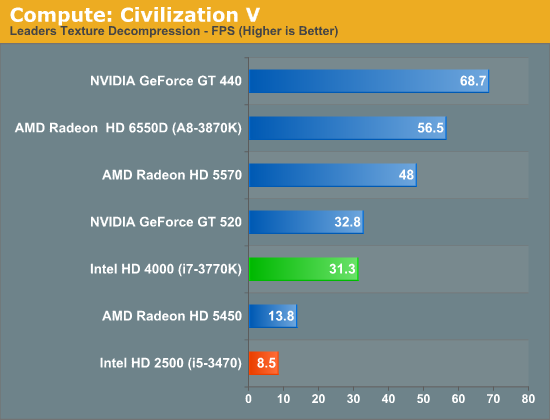
These compute results are mostly academic as I don't expect anyone to really rely on the HD 2500 for a lot of GPU compute work. With under 40% of the EUs of the HD 4000, we get under 30% of the performance from the HD 2500.
We have our second compute test: the Fluid Simulation Sample in the DirectX 11 SDK. This program simulates the motion and interactions of a 16k particle fluid using a compute shader, with a choice of several different algorithms. In this case we’re using an (O)n^2 nearest neighbor method that is optimized by using shared memory to cache data.
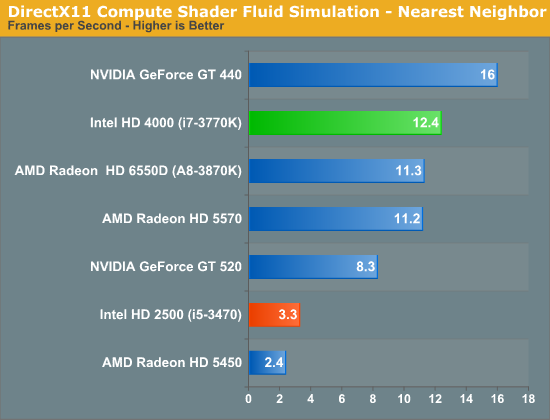
Thanks to its large shared L3 cache, Intel's HD 4000 did exceptionally well here. Thanks to its significantly fewer EUs, Intel's HD 2500 does much worse by comparison.
Our last compute test and first OpenCL benchmark, SmallLuxGPU, is the GPU ray tracing branch of the open source LuxRender renderer. We’re now using a development build from the version 2.0 branch, and we’ve moved on to a more complex scene that hopefully will provide a greater challenge to our GPUs.
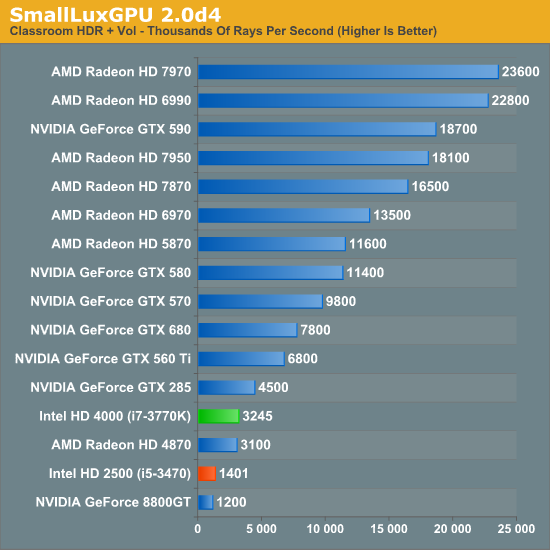
Intel's HD 4000 does well here for processor graphics, delivering over 70% of the performance of NVIDIA's GeForce GTX 285. The HD 2500 takes a big step backwards though, with less than half the performance of the HD 4000.
Synthetic Performance
Moving on, we'll take a few moments to look at synthetic performance. Synthetic performance is a poor tool to rank GPUs—what really matters is the games—but by breaking down workloads into discrete tasks it can sometimes tell us things that we don't see in games.
Our first synthetic test is 3DMark Vantage’s pixel fill test. Typically this test is memory bandwidth bound as the nature of the test has the ROPs pushing as many pixels as possible with as little overhead as possible, which in turn shifts the bottleneck to memory bandwidth so long as there's enough ROP throughput in the first place.
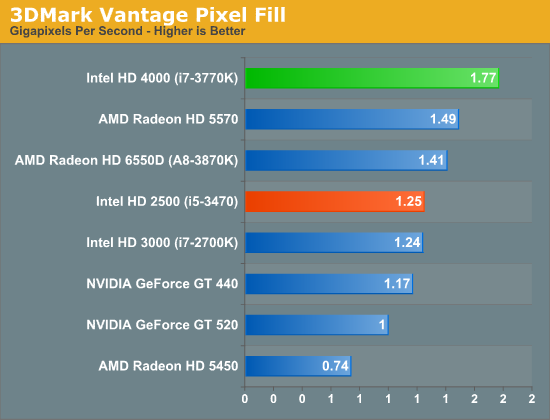
It's interesting to note here that as DDR3 clockspeeds have crept up over time, IVB now has as much memory bandwidth as most entry-to-mainstream level video cards, where 128bit DDR3 is equally common. Or on a historical basis, at this point it's half as much bandwidth as powerhouse video cards of yesteryear such as the 256bit GDDR3 based GeForce 8800GT.
Moving on, our second synthetic test is 3DMark Vantage’s texture fill test, which provides a simple FP16 texture throughput test. FP16 textures are still fairly rare, but it's a good look at worst case scenario texturing performance.
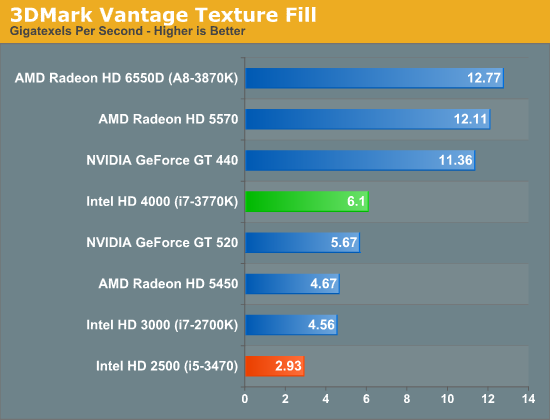
Our final synthetic test is the set of settings we use with Microsoft’s Detail Tessellation sample program out of the DX11 SDK. Since IVB is the first Intel iGPU with tessellation capabilities, it will be interesting to see how well IVB does here, as IVB is going to be the de facto baseline for DX11+ games in the future. Ideally we want to have enough tessellation performance here so that tessellation can be used on a global level, allowing developers to efficiently simulate their worlds with fewer polygons while still using many polygons on the final render.
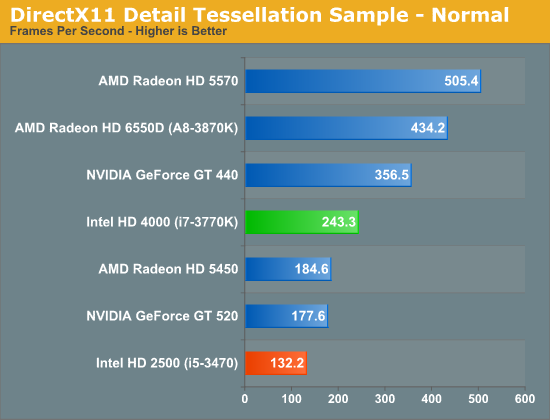
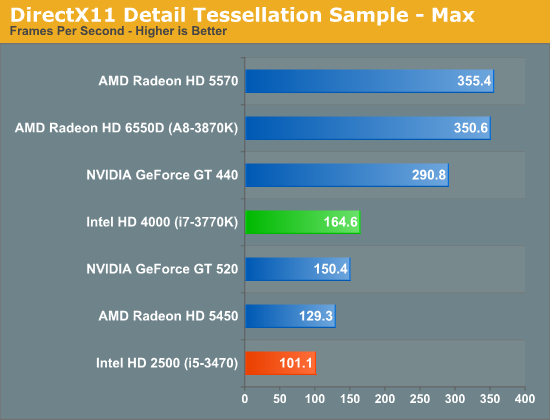
The results here are as expected. With far fewer EUs, the HD 2500 falls behind even some of the cheapest discrete GPUs.
GPU Power Consumption
As you'd expect, power consumption with the HD 2500 is tangibly lower than HD 4000 equipped parts:
| GPU Power Consumption Comparison under Load (Metro 2033) | ||||
| Intel HD 2500 (i5-3470) | Intel HD 4000 (i7-3770K) | |||
| Intel DZ77GA-70K | 76.2W | 98.9W | ||
Running our Metro 2033 test, the HD 4000 based Core i7 drew nearly 30% more power at the wall compared to the HD 2500.










67 Comments
View All Comments
duploxxx - Thursday, May 31, 2012 - link
you could ask why even bother to add a GPU here, it is utter crap.now lets have a look at teh other review what they left in the U 17W parts ......
PrinceGaz - Thursday, May 31, 2012 - link
Because most people don't buy a PC to play the latest games or do 3D rendering work with it.CeriseCogburn - Monday, June 11, 2012 - link
Correct PrinceGaz, but then we have the amd fan boy contingent, that for some inexplicably insane fatnasy reason, now want to pretend llano, trinity and hd graphics are gaming items...The whole place has gone bonkers. But a freaking video card, every *********** motherboard has one 16x slot in it.
mother of god !
ananduser - Thursday, May 31, 2012 - link
I noticed you ran a BF3 bench and assumed that the game is playable on a HD4000. Have you actually played the game with the HD4000 on a 32 player map. I dare you to try and update this review and say that BF3 is "playable" on a HD4000.JarredWalton - Thursday, May 31, 2012 - link
"The HD 4000 delivered a nearly acceptable experience in Battlefield 3..." I wouldn't call that saying the game is "playable". Obviously, the more people there are on a map the worse it gets, but if you're playing BF3 on 32 player maps (or you plan to), I'd hope you understand that you'll need as much GPU (and quite a bit of CPU) as you can throw at the game.That said, I'll edit the paragraph to note that we're discussing single-player performance, and multiplayer is a different beast.
ananduser - Thursday, May 31, 2012 - link
Well, when one sees 37 fps BF3, one might wrongly assume that: "OMG 37 FPS on a thin and low powered [insert ultrabook brand]"; I'm going tomorrow and buying it.I think that playing the game for 5-10 minutes with FRAPS enabled and providing highest/lowest FPS count for each hardware setup is more revealing than running built-in engine demos.
CeriseCogburn - Friday, June 1, 2012 - link
Don't forget this applies to AMD Trinity whose crappy cpu will cave in on a 32 player server.ananduser - Thursday, May 31, 2012 - link
Oh and I doubt single player performance will ever touch that 37 data point as well.JarredWalton - Thursday, May 31, 2012 - link
On the quad-core desktop IVB chips it surely will -- that's why the result is in the charts -- but for laptops? Nope. I think the best result I've gotten (at minimum details and 1366x768) is around 25-26FPS in BF3.ltcommanderdata - Thursday, May 31, 2012 - link
"Intel has backed OpenCL development for some time and currently offers an OpenCL 1.1 runtime for their CPUs, however an OpenCL runtime for Ivy Bridge will not be available at launch. As a result Ivy Bridge is limited to DirectCompute for the time being, which limits just what kind of compute performance testing we can do with Ivy Bridge."http://software.intel.com/en-us/articles/vcsource-...
The Intel® SDK for OpenCL Applications 2012 has been available for several weeks now and is supposed to include GPU OpenCL support for Ivy Bridge. Isn't that sufficient to enable you to run your OpenCL benchmarks?
http://downloadcenter.intel.com/Detail_Desc.aspx?a...
If not, the beta drivers for Windows 8 also support Windows 7 and adds both GPU OpenCL 1.1. support and full OpenGL 4.0 support including tessellation so would allow you to run your OpenCL benchmarks and a Unigine Heaven OpenGL tessellation comparison.